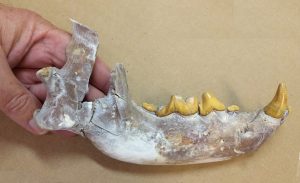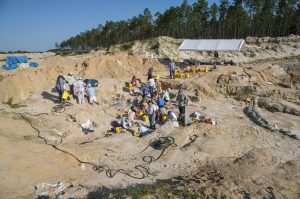
Florida Museum photo by Jeff Gage
GAINESVILLE, Fla. — Florida Museum of Natural History paleontologists are recruiting volunteers to help excavate a recently discovered site in eastern Levy County that has produced thousands of fossils, including more than 55 vertebrate species.
Researchers are enthusiastic about the 5- to 5.5 million-year-old fossils being recovered and say it is the first site of this particular age found in North Central Florida.
“No other fossil site of this age in the southeastern United States produces such a rich abundance of freshwater vertebrates,” said Florida Museum curator of vertebrate paleontology Jonathan Bloch. “This is an important resource in understanding the evolutionary history of this ecosystem in the region.”
Volunteers, who dig side-by-side with museum staff, must be at least 15 years old, and able to work outdoors and walk over uneven terrain. To volunteer, visit www.floridamuseum.ufl.edu/vertpaleo/volunteering/field/ to download an application and view the schedule. The excavation will continue into the spring.
Museum vertebrate paleontology collections manager Richard Hulbert, who is managing the dig with Bloch, said the fossils recovered range in size from small mice and salamanders to a multi-ton distant relative of present-day elephants.

Florida Museum photo by Jeff Gage
“We are finding many fossils of extinct rhinos, llamas, horses and the elephant-like gomphotheres,” Hulbert said.
Significant discoveries are often made by volunteers. One key specimen was found by museum volunteer and Gainesville resident Peter Roode. He uncovered a nearly complete lower jaw of Borophagus hilli, an extinct species belonging to the family Canidae, which includes today’s wolves, foxes and the domestic dog. While about as large as a modern gray wolf, it was a specialized scavenger like a hyena with short, massive jaws and teeth that could break bones.
“Dr. Hulbert told me I had just found the first carnivore at this site,” Roode said. “What I was seeing, of course, was the left mandible of Borophagus.”
In August 2015, workers on a tract of private land near Williston excavated a small pit for clay to build dirt roads. A few months later, Florida Museum researchers were contacted after fossils were seen in the pit.
And much more has been found at the site. The discovery of new species is also possible.
Most of the fossils are from animals living in or near the river, such as alligators, fish, salamanders, turtles and water snakes. Workers have also recovered fossils of birds and mammals, including cormorants, ducks, loons, rails, swans and two species of otters.
“We really never know exactly what to expect when we dig in a new site like this,” Bloch said. “Paleontologists are a bit like fisherman in that the excitement of the hunt is always there. We are always hoping that the next fossil from this ancient river will be the catch of a lifetime.”
-30-
Writer: Elizabeth Brown, 352-273-2034, ebrown@flmnh.ufl.edu
Sources: Jonathan Bloch, jbloch@flmnh.ufl.edu; Richard Hulbert, rhulbert@flmnh.ufl.edu
Media contact: Paul Ramey, 352-273-2054, pramey@flmnh.ufl.edu